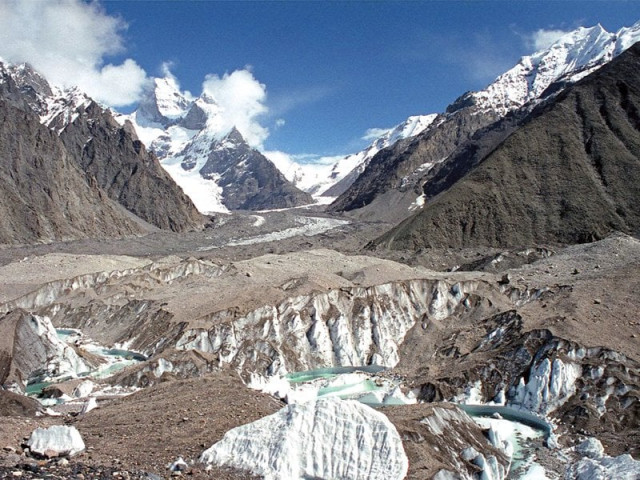Scientific venture: How much is climate change hurting glaciers?
International researchers will enhance knowledge of Karakoram glaciers.

A composition along Baltoro Glacier’s surface. PHOTO: FILE
EvK2CNR has been working in the Karakoram region for the past 30 years and has also been involved in the Sustainable Economic Environment Development (SEED) project in Central Karakoram National Park.
The organisation launched a study to quantify short-term changes and variability of the Karakoram glaciers, research on permafrost in the Karakoram and Deosai areas, and a project to establish an air quality monitoring station at Deosai.
Climate Observatory and Air Quality Monitoring
EvK2CNR Researcher Gian Pietro Verzi said air quality monitoring involves setting up a climate observatory at the Deosai plateau in collaboration with the Pakistan Meteorological Department (PMD) and Wapda.

He said the Deosai plateau was selected because it is a clean place, far from local emissions and the giant air masses that flow freely over the plateau provide a high sensitivity to trace ozone and black carbon.
He said the researchers are trying to test how atmospheric brown clouds moves over high altitudes.
“The Deosai station will help the international community trace the movement of global pollutants at high altitudes,” Verzi said. “There are no clean countries or dirty countries. It is an international issue now”.
The observatory will use a low-powered, lightweight device called “Nano-share” which will measure the levels of atmospheric ozone (O3), aerosol, oxides of carbon and particulate matter in addition to recording standard weather data, informed Verzi.
The Nano-share is encased in a three-foot high suitcase, weighs around 35kg and is powered by a 40-watt battery, Verzi stated, adding that it’s a portable device to monitor air quality.

From July to October 2013, the research team will carry out an atmospheric campaign in Concordia to monitor the atmospheric composition along Baltoro Glacier’s surface. Baltoro is one of the longest glaciers outside the Polar Regions.
Glacier measurements in Baltoro
A team of researchers led by Christoph Mayer, a professor at the Bavarian Academy of Science and Humanities who has previously worked in the Karakoram Mountain Range since 2004, will perform glacier-related measurements in the Baltoro area.
The measurements will include the mapping of debris cover, ice melt, snow thickness and density, Mayer said.
He said the research team will use a network of poles that will be buried in the glacier’s surface. The height of snow on the pole and the position of the poles will be observed over time to determine changes in snow levels and the velocity of the glacier’s movement, Mayer said.
“The trend of the Baltoro glacier is that it is reducing in size, but the pace is very slow compared to other glaciers”.
But Mayer said more elevation profiles of the glacier are needed to quantify the reduction in centimetres.
Mapping permafrost distribution in Karakoram and Deosai
Permafrost is a subsurface layer that remains below zero degrees Celsius for at least two years, according to Renato Collucci, a researcher at the National Research Council in Italy.
Collucci said permafrost is directly linked with climatic conditions and can become dangerous because sudden melting of permafrost could cause slope instabilities that can lead to landslides and debris flows. He said accurate mapping of permafrost is also important for water management because permafrost degradation can cause changes in water quality and chemistry, adding that there is no thermal or ice content data about it in Pakistan. The study, he said, will aim in mapping permafrost distribution and modelling it using satellite and on-ground measurements to determine ice content and permafrost thickness.
Published in The Express Tribune, June 24th, 2013.


















COMMENTS
Comments are moderated and generally will be posted if they are on-topic and not abusive.
For more information, please see our Comments FAQ